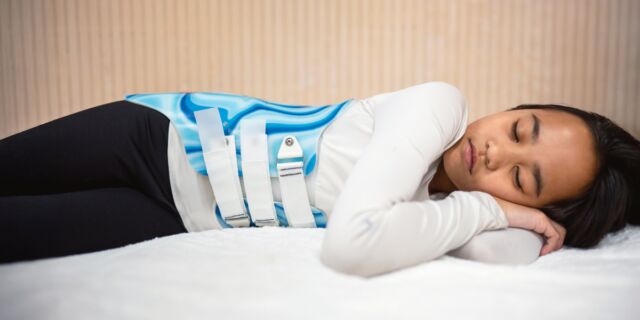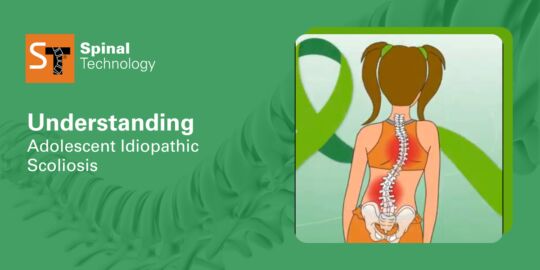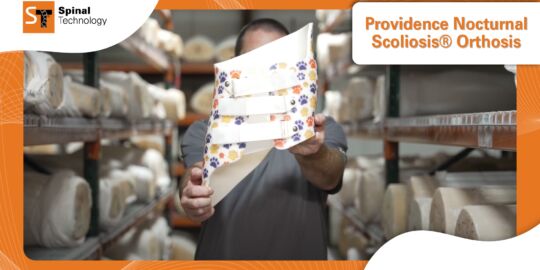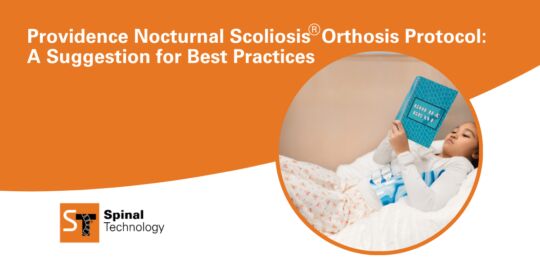A Parent's Guide to the Providence Nocturnal Scoliosis® Brace
Providence Nocturnal Scoliosis® Orthosis
The Providence Nocturnal Scoliosis® Orthosis was developed at Rhode Island Hospital by Barry McCoy an American Board Certified Orthotist Prosthetist and Dr. Charles D’Amato M.D. an Orthopedic Surgeon. The clinical development team also included a team of nurses and therapists.
The Providence Nocturnal Scoliosis® Orthosis is a night time hyper-corrective bracing system. It is designed for the patient to wear overnight while in the supine position. The Providence Nocturnal Scoliosis® Orthosis utilizes a specialized measuring board and advanced CAD/CAM technology. Because of these advanced technologies, consistent and precise orthotics are able to be produced for each individual patient.
The primary objective of Providence Nocturnal Scoliosis® Orthosis is to push the spine to the midline via lateral and de-rotational forces. Not to be confused with “bending type” braces, the Providence® is a hyper corrective orthosis, maximizing the correction upwards of 98% to 115% during the optimal hours of brace wear, at night, without the need for daytime bracing. Spinal Technology defines the objective of the Providence® Orthosis as moving the apices of scoliotic curves to the midline or beyond the midline via the application of controlled direct, lateral and de-rotational forces on the spine (Spinal Technology Inc, 2020).

The Providence Nocturnal Scoliosis® System has an increased compliance rate among adolescents compared to other bracing systems, because it is worn only overnight. This creates an opportunity for the adolescent to wear the brace in the privacy of their own home, and avoid the social challenges of wearing a brace during the day, when it can create emotional stress at a time when they want to make sure they fit in with their friends. Because of this, these adolescents are more compliant to wear the brace, thereby increasing the efficacy of this Providence® Nocturnal bracing system. Wearing the brace at night also alleviates the patient from the uncomfortable experience that is associated with wearing a full time, full coverage brace.
Wearing the nighttime Providence® brace provides the benefit of taking advantage of a time in which the Human Growth Hormone (HGH) levels are elevated, which correlates with critical growth hours. Treating a scoliotic curve is most effective when the spine is in a corrected state during periods of growth. The peak levels of Human Growth Hormone are between midnight to two in the morning. By utilizing a brace that provides for hyper correction of the curves during these optimal hours, the Providence Nocturnal Scoliosis® Orthosis takes advantage of spinal growth plate physiology, allowing for symmetrical growth of the vertebra, and reducing the need for continuous bracing throughout the day.
“The Providence is a hyper corrective orthosis, maximizing the correction upwards of 98% to 115% during the optimal hours of brace wear, at night, without the need for daytime bracing.”
What patient population is the Providence® Orthosis Suited for?
The Providence Nocturnal Scoliosis® Brace is used in patients who have been diagnosed with Adolescent Idiopathic Scoliosis. It has also been deemed an effective orthosis for patients who are neurologically involved, idiopathic adolescents, obese patients and those with juvenile scoliosis. Patients who have scoliosis with an upper limit of T6 can be treated with this nocturnal Providence® Orthosis because it is able to target an apex at the T6 level. Those who have apices above the T6 spinal level can be effectively treated with a cervical extension which can be attached to the nocturnal Providence® orthosis (Spinal Technology Inc, 2020).
Overview Adolescent Idiopathic Scoliosis (AIS)
Scoliosis is defined by the American Association of Neurological Surgeons (AANS) as an, “abnormal lateral curvature of the spine” (AANS, 2020), and is accompanied by rotation of the vertebra. Scoliosis is diagnosed by evaluating the spinal curvature in the coronal (frontal) plane. It is within the coronal (frontal) plane that the actual degree of the abnormal curvature of the spine can be measured (AANS, 2020). If this coronal (frontal) plane measurement of the abnormal spinal curvature is greater than 10 degrees, the diagnosis of scoliosis can be made (Choudhry, 2016). The most common form of scoliosis is known as Adolescent Idiopathic Scoliosis. AIS is responsible for 80% of all cases, and is a diagnosis made only after other causes of scoliosis have been excluded (AANS, 2020). Children between the ages of 10 years old to 18 years of age are the most commonly affected by AIS. The AIS curve progresses rapidly during the period of skeletal growth. Progressions of scoliotic curve can continue to occur into adulthood, especially in those patients who have scoliotic curves greater than 60 degrees. There are many theories as to the underlying etiology that results in the development of AIS; however, there has not been any definitive research to suggest what the specific cause is for those who develop Adolescent Idiopathic Scoliosis (Scoliosis Research Society, 2020).
Symptoms of Adolescent Idiopathic Scoliosis
Classic symptoms of AIS can vary depending on the severity of the abnormal curvature. Scoliosis can be categorized as mild, moderate or severe based on the degree of abnormal spine curvature. Each of these different categorizations of scoliosis are separated by the degree of abnormal curvature, which is measured using the Cobb angle.
According to Dr. Mostafa El-Feky et. al., (2020) the Cobb angle is defined as, “the most widely used measurement to quantify the magnitude of spinal deformities, especially in the case of scoliosis, on plain radiographs. Scoliosis is defined as a lateral spinal curvature with a Cobb angle of > 10 degrees” (El-Reky et. al., 2020).
Mild scoliosis is defined as having an abnormal spinal curvature with a Cobb angle between 10 degrees and 25 degrees (South Florida Scoliosis Center, 2017). Mild scoliosis does not usually present with any physical symptoms, and is normally first observed during a routine physical examination screening for scoliosis which is performed during physical education class, or upon evaluation by a primary
care physician.
Moderate scoliosis is when the abnormal lateral spinal curvature exceeds 25 degrees. Moderate scoliosis is defined as scoliotic curve between 26 degrees and 40 degrees. This can be measured on plain radiographs via the Cobb angle. Symptoms associated with moderate scoliosis may include physical discomfort, fatigue with physical activity, and visible asymmetry in the spine, ribs, shoulders, or hips.
Severe scoliosis is defined when the lateral abnormal curvature of the spine measured on plain radiographs via the Cobb angle exceeds 40 degrees. When the scoliotic curve is greater than 40 degrees it can result in many physiologic symptoms that include many of the body’s systems. Symptoms may include all of the following which were included in both the mild and moderate forms of scoliosis. However, severe scoliosis may present with more severe symptoms including: more prominent rib hump, increased fatigue with sedentary positions as well as with physical activity, clumsy or prone to falls; increased respiratory effort which includes shortness of breath associated with physical activity; pain especially in the spine and lower back and headaches (South Florida Scoliosis Center, 2017). This is the most severe form of scoliosis and can be detrimental to the health of those who suffer from this disease, if the appropriate intervention is not initiated.
Diagnosis of Adolescent Idiopathic Scoliosis
Diagnosis for Adolescent Idiopathic Scoliosis normally occurs during a routine scoliosis screening. These routine scoliosis screenings occur during a physical examination that occurs during physical education class, or upon evaluation by a primary care physician. These screening tests can lead to the diagnosis of scoliosis, and the recommendation for more specialized evaluation.
During this screening test, the Adams Forward Bend Test will be performed. The Adams Forward Bend Test allows for the practitioner to evaluate the anatomy of the patient to determine if there is an abnormal spinal curvature. The practitioner is able to assess the patient and determine if there is an abnormal curvature to the spine and evaluates the symmetry of the hips, ribs and/or shoulders. According to the Boston Children’s Hospital (2020), the Adams Forward Bend Test is performed by, “the patient puts their hands together and bends forward with straight knees, making their spine visible”(Boston Children’s Hospital, 2020). If there is a notable asymmetry, primarily through the presence of raised “rib hump” on one side of the back, then a scoliometer can be utilized to measure the degree of the curve. When the scoliometer measures a spinal curve of greater than 5-7 degrees then the patient may have scoliosis and should have further evaluation and follow up to determine a definitive diagnosis (Boston Children’s Hospital).
“The Adams Forward Bend Test allows for the practitioner to evaluate the anatomy of the patient to determine if there is an abnormal spinal curvature. The practitioner is able to assess the patient and determine if there is an abnormal curvature to the spine and evaluates the symmetry of the hips, ribs and/or shoulders.
If scoliosis is observed via a routine screening test performed during physical education class, then the recommendation will be for the student to follow up with his/her primary physician. Once the student follows up with the primary physician, then he/she will be assessed for scoliosis again utilizing the Adams Forward Bend Test to verify results obtained at outside institution. Once confirmed that the scoliometer does indicate a greater than 5-7 degree abnormal spinal curvature then further studies may be indicated. During this primary physician follow up, a complete medical history will be obtained which includes the patient’s past medical history, medications, allergies to any medications, past surgical history and family history of any medical conditions such as scoliosis. The physician will then perform a physical exam and obtain a set of radiographs that evaluate the patient’s spine to determine the degree of any abnormal curvature. It is the Cobb angle that is measured on these spine radiographs to determine the degree of abnormal curvature (Boston Children’s Hospital, 2020).
The spine radiographs will help to determine the specific physical characteristics associated with scoliosis. These characteristics include the location, shape, direction, and degree, or magnitude, of the curve and its rotation. The shape of the scoliotic curve may often be “S” shaped or “C” shaped, while more complex variations can often occur as well. The direction of the curve may be left, right or have clinical indications of both left and right curves within the spine. Scoliosis can present in the thoracic, lumbar, and cervical levels of the spine. The degree of the curve as measured via the Cobb angle will help to differentiate the types of scoliosis and determine the appropriate management protocol (Boston Children’s Hospital, 2020).
Treatment Options for Adolescent Idiopathic Scoliosis
There are many different treatment options available for patients with Adolescent Idiopathic Scoliosis. The specific intervention will vary based on individual assessment and each intervention should be tailored to the specific patient’s needs and medical evaluation. However, there are some generalized practice guidelines that will help guide in the management of the three categorizations of scoliosis: mild, moderate and severe.
As described above, mild scoliosis is defined as a Cobb angle less than 25 degrees. The indicated management for these patients may include observation, or often orthotic management, to prevent progression. For moderate scoliosis, which is defined as having a Cobb angle of greater than 25 degrees to around 40-45 degrees, the primary treatment modality is through the use of a scoliosis orthosis, or brace, to prevent further progression and avoid the potential need for surgical intervention. Finally, patients who have severe scoliosis, which means that the Cobb angle is greater than 40-45 degrees, and depending on the patients skeletal maturity or remaining growth, then surgery may be the indicated plan for treatment. However, bracing is often prescribed to minimize, or potentially prevent the need for such surgery. While these are generalized guidelines to help guide the management of patients with these degrees of scoliosis, it is not a rigid protocol. Each treatment plan must be tailored to the individual patient so that he/she receives the most appropriate standard of care.
Scoliosis patients should be regularly monitored by their primary care physician, with routine physical examinations that will indicate if the scoliosis is stable or progressing. Monitoring is especially essential during periods of skeletal growth. For girls, periods of skeletal growth normally occurs between the ages of 10 years old to 14 years old. For boys, periods of skeletal growth usually occur between the ages of 12 years and 16 years (Boston Children’s Hospital, 2020). However, every person grows at their own rate and timeline, so identifying scoliosis and intervening with treatment, is best and most successful in the earlier stages of growth.
“These braces are utilized with the intent of correcting the asymmetry, stopping the progression of the curves, and preventing the need for surgery.
Orthotic management is indicated for patients within a wide range of scoliosis severity. These braces are utilized with the intent of correcting the asymmetry, stopping the progression of the curves, and preventing the need for surgery. Scoliosis braces are uniquely designed to meet the needs of the patient who has been diagnosed with scoliosis. These specialized braces are designed so that they address the specific individualized curve that is completely unique to the individual. The brace works to straighten the patient’s spine during the skeletal growth phase; therefore, preventing the further progression of the curve (Boston Children’s Hospital, 2020).
As a last resort, surgery may be indicated for patients with severe scoliosis. In patients with severe scoliosis they have a Cobb angle greater than 40-45 degrees which may result in significant cardiopulmonary compromise. As the abnormal curve continues to progress, there can be respiratory compromise. Therefore, it is when these negative outcomes begin to present that surgery may be indicated. The goal is to delay the surgery until after the patient has completed his/her growth spurt (Boston Children’s Hospital, 2020).
Review of Medical Literature
There have been many studies that have evaluated the efficacy of nighttime braces for the treatment of Adolescent Idiopathic Scoliosis. The Providence® Orthosis is a nighttime brace that has proven its efficacy according to the research studies in the literature.
According to the Spine Magazine, Volume 26 published in November 2001, there was success in treating even those with large degree abnormal scoliotic curvatures. This study specifically evaluated the efficacy of the Providence Nocturnal Scoliosis Orthosis system in terms of curve magnitude. The study evaluated how well the Providence Orthosis was able to effectively treat high magnitude curves. There were equal number of patients in each group. Patient success and failure was described in terms of severity of abnormal curvature. The first group evaluated the effectiveness of the Providence® Nighttime Orthosis in patients who had curves between 20-24 degrees. The percent success rate in treatment of the patients in this group with the Providence® Orthosis was 81%; while the percent failure was much less at 19%. In treating patients with the Providence Orthosis who had spinal curves between 25-34 degrees, the success rates were 71%, with the failure rate being much less at 29%. Finally, in those patients who have severe scoliotic curves between 35-42 degrees, the treatment success rates with the use of the Providence® Orthosis was 63% and the failure rates were 37%. As you can see, the Providence® Orthosis via this study has been shown to improve outcomes in patients with Adolescent Idiopathic Scoliosis, even in those patients with severe forms of the disease.
This is extremely important because the younger the patient, the larger the abnormal curve in the spine, the greater the chance of progression of this curve. Therefore, treating these curves before they progress can really make an impact on the quality of life of the patient.
The European Spine Journal, Volume 28 published in 2019 evaluated the effectiveness of the Providence nighttime brace for patients with Adolescent Idiopathic Scoliosis in patients with curves between 20 degrees and 45 degrees.
This study evaluated 124 patients with AIS all with Cobb angles greater than 20 degrees, remaining growth potential and no previous treatment for scoliosis. Of the 124 patients, 80 of those patients terminated brace treatment and followed up with their physician. Patients were monitored and evaluated via radiographs for progress. The results found that the mean in-brace correction was 82% and curve progression was observed in 9 patients. Brace treatment was successful in an overall 89% of patients. Of these 89% of patients who were treated successfully with the Providence® Brace, 88% had Cobb angles between 20-29 degrees, while 93% of the patients had Cobb angles between 30-39 degrees. Finally, of those patients 77% had Cobb angles between 40-45 degrees. Of those 80 AIS patients, 5 of them surgery was clinically indicated. The conclusions of this study indicated that Providence® nighttime braces as a means of treatment for Adolescent Idiopathic Scoliosis was effective even in large Cobb angle deformities. These results were comparable to the major full-time Boston brace (Simony, 2019).
An article published titled, “Nighttime Bracing with the Providence Brace in Adolescent Girls with Idiopathic Scoliosis”(2001) was a prospective study that evaluated 102 female patients with Adolescent Idiopathic Scoliosis. These patients met the inclusion criteria and were treated with the Providence® Nighttime Orthosis. The results found that, “in-brace correction with a supine radiograph was 96% for major curves and 98% for minor curves. Seventy-five patients (74%) did not progress >5° and 27 patients (26%) progressed ≥6° or went on to surgery. Twenty-nine percent of Risser 0 or 1 patients progressed and 17% of patients Risser 2 progressed”(D’Amato, 2001). Those patients with apexes between T8 and L1 had a 76% success when treated with the Providence® Orthosis. According to the article, “With the Providence brace, 63% of thoracic curves and 65% of double curves were successful. Ninety-four percent of lumbar curves and 93% of thoracolumbar curves were successful”(D’Amato, 2001). These results suggest that the Providence® Orthosis is beneficial in the treatment of Adolescent Girls with Idiopathic Scoliosis under certain circumstances.
Results/Conclusions
The Providence® Nighttime Brace has been utilized as a modality to treat patients with Adolescent Idiopathic Scoliosis. This brace is worn at nighttime only and provides the adolescent with an opportunity to still fit into his/her social group, because he/she does not have to wear the brace outside of his/her home.
This removes moves the stigma of embarrassment associated with full-time full contact scoliosis braces. The Providence® Nighttime Brace is utilized in many different patient populations, but has found a great benefit to those who suffer from obesity.
The Providence® Orthosis, after literature review has shown how effective it is in the treatment of scoliotic curves, even those Cobb angles that are within the moderate to severe categories of scoliosis.
The Providence® Nighttime Brace offers many benefits.
Works Cited
Scoliosis Research Society. Adolescent Idiopathic Scoliosis. (2020).
American Association of Neurological Surgeons. Scoliosis. (2020).
Choudhry, M. N., Ahmad, Z., & Verma, R. (2016).
Adolescent Idiopathic Scoliosis. The open orthopaedics journal, 10, 143–154.
U.S. National Library of Medicine. MedlinePlus. (2013).
El-Feky, M., Thuaimer, A., et. al., (2020). Cobb Angle. Radiopaedia.
South Florida Scoliosis Center (2017).
Boston Children’s Hospital. Scoliosis Diagnosis & Treatment. (2020).
Spine Magazine, Volume 26 published in November 2001.
Simony, A. Et. al, (2019). Providence® nighttime bracing is effective in treatment for adolescent idiopathic scoliosis even in curves larger than 35°. Volume 28; Issue 9.
Roland d’Amato, Charles, MD, FRCS(C); Griggs, Sean, MD; McCoy, Barry, MEd, CPO
Nighttime Bracing With the Providence® Brace in Adolescent Girls With Idiopathic Scoliosis, Spine: September 15, 2001 - Volume 26 - Issue 18 - p 2006-2012.


